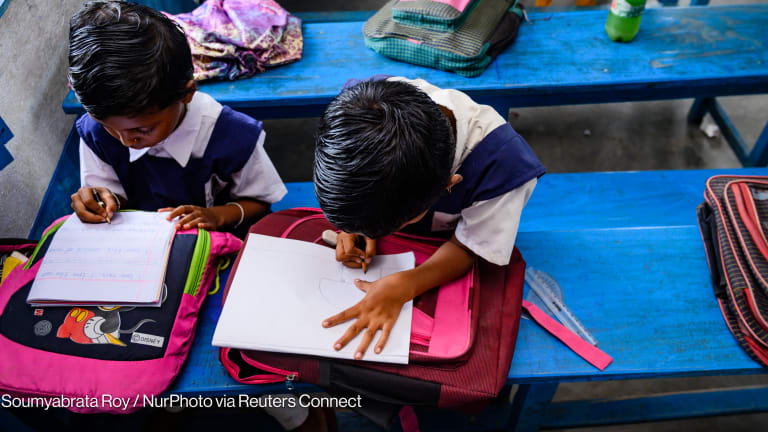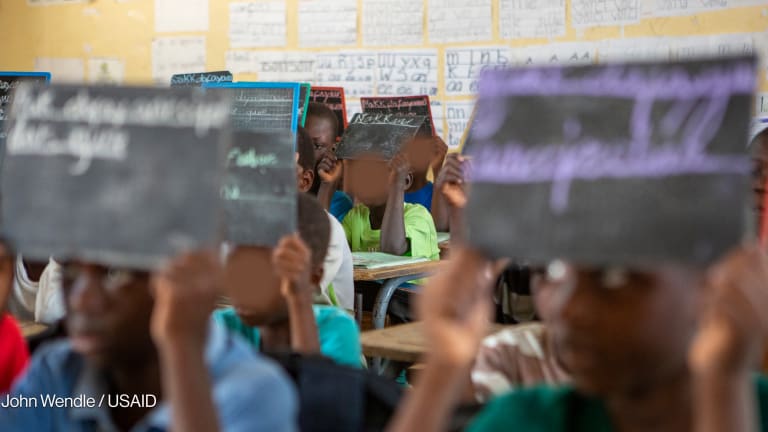
This article usually requires a Devex Pro subscription to read, but we made it free for you so you can get a taste of the exclusive insights and deeper analysis we provide our subscribers. Get unlimited access to Devex Pro by becoming a subscriber. You’ll be supporting a team of global journalists reporting on the forces shaping global development to help you get ahead of the news, trends, and conversations. Try Devex Pro for 15 days for free.
You can read more on this topic in these articles:
► The Gates Foundation's evolving global education strategy
► Education, identified as UK priority, still badly hit by aid cuts
► Germany commits extra €200M to Education Cannot Wait
LONDON — In 2005, American technology guru Nicholas Negroponte vowed to revolutionize education in low-income countries by parachuting in $100 laptops loaded with reading material so that children could teach themselves to read — in some cases literally dropping the devices from helicopters as one of the first big experiments with global education technology.
Fifteen years on, his One Laptop per Child program, although still operating in some countries, is widely regarded as a major flop — the computers went way over budget, users complained of hardware failures but lacked the expertise to fix them, and evaluations found that the laptops did not lead to academic gains.
While most educators agree that technology has a role to play in meeting the immense challenges facing education systems in low-income countries — where more than 380 million children are expected to finish primary school unable to read or do basic math, and millions more are not in school at all — there is fierce debate over how ed tech should be designed and used.
One Laptop per Child has come to be seen by critics as a classic example of “American hubris” in supporting top-down, tech-driven, one-size-fits-all approaches to a complex and context-specific problem.
But ed tech has come a long way since then. Donors and implementers are starting to think far less about the technology itself and more about if and how it fits into existing education systems. More funding is going into research — which experts say is sorely needed — and thorny issues such as governance and politics are in the frame.
“Ed tech is still a work in progress ... but a lot has changed in recent years. It used to be very hardware focused and there was this idea that you could put technology into schools and magic would happen, but that’s no longer the case,” Girin Beeharry, who heads up the Bill & Melinda Gates Foundation's global education work, told Devex.
Tablets for teachers
More on education
► UNESCO issues dire projections for 2030 education targets
► Education advocates claim 'groundbreaking' victory on latest GPE decision
As part of this new approach to ed tech, focus has shifted away from learner-led interventions that put digital textbooks and other tech tools in the hands of students. Now, more programs are giving devices and apps to teachers to support their performance and professional development — for example, by reducing their administrative workload so they have more time for teaching, or by standardizing lessons through scripted plans — as well as to school managers to boost accountability and data collection.
The world’s largest global education donor, the World Bank, is increasingly focusing on teacher performance, for example, through Teach, its open-source classroom observation tool.
This marks a seismic change in the use of ed tech, which has often been characterized as trying to bypass or replace teachers, according to Ben Piper, regional advisor for Africa at U.S. research institute RTI International, which has worked on a number of ed tech interventions. The failure to include teachers has contributed to a number of failures, he said.
Susan Nicolai, senior research fellow at the Overseas Development Institute, a London-based think tank, agreed.
“Generally, there’s more promise in terms of using technology to support education management … [and] teachers than getting tech into the hands of students,” she said, adding that “the sector has moved so far beyond One Laptop per Child.”
However, experts remain cautious. There is still very little data on the impact of technology on learning outcomes and education systems more broadly, including if and how it can improve teaching.
A model in development
The teacher-tablet model was pioneered by Bridge International Academies, a for-profit company running schools in a number of African countries. Bridge’s teachers are given tablets loaded with detailed lesson plans and instructions written by Bridge staff in the U.S., which teachers recite from. The approach means Bridge can hire local high-school graduates to work as teachers and read from tablets, instead of only employing more expensive government-trained teachers.
The tablets also feed data back to the company to track the teacher’s activity and attendance and ensure they are sticking to the lesson plans. Other school chains, such as Rising Academies and Omega, have followed suit in giving their teachers tablets, although their lesson plans are less rigid.
While Bridge says the model has improved test scores among its students, teachers’ unions and some civil society groups say it is doing more harm than good. They argue that the tablets undermine teacher autonomy, prevent their professional development, and get in the way of valuable teacher-student interaction.
Piper agreed that Bridge-type models can be problematic if the technology is designed to be “teacher-proof,” he said. “Technology needs to be designed to ... help the teacher to teach better, as opposed to a lot of the designs of these tablet-based programs which is ‘how do I skip the teacher,’” he said.
However, Jamie Martin, founder of Injini, which incubates African ed tech startups, defended the approach, saying that unskilled and absent teachers are a major part of the current education crisis.
“It’s an unpopular view, but we need to be honest about how low the capability of teachers in the developing world is … and so they need more guidance,” he said.
“I’ve never understood why having someone plan lessons for them, which teachers often dislike and struggle with, is such a problem,” he added.
Bridge’s Chief Academic Officer Sean Geraghty told Devex in an email that “the teacher tablet and the lesson guides that Bridge uses are an extremely important part of our approach but only when used to complement the other aspects of our classroom and teacher support.”
Tablets for management and training
Giving technology to coaches to help train teachers, and to school managers to monitor and improve teacher performance, is one of the most promising emerging applications of ed tech, experts said. However, while there is some evidence about the impact, the approach is still nascent, according to Piper, who has been involved in trials in Kenya.
Tusome, an early-grade reading program in Kenya, which includes a coach-and-tablet element, is one of the best-known and evaluated examples. Funded by the U.S. Agency for International Development, with support from the U.K. Department for International Development, it aims to improve learning outcomes for 7 million children.
The technology component centers around an adapted coach-specific version of Tangerine mobile assessment tool, which is loaded onto tablets and given to teacher coaches who observe and support teachers, and assess a handful of their pupils, offering suggestions on how to improve.
The data collected by the coaches is used by school management to see which teachers need support and in what areas, and by government officials to get a better picture of what is going on in local education systems, while also building a national picture of where to prioritize resources.
RTI’s Piper led a national evaluation of the tablet element of the program in 2017. The results were positive, offering “some indication” that it “can change behavior and outcomes,” the study concluded. Piper added that “the excitement of the tablet approach and the power of the data ... allowed the government to better manage their entire system,” improving government buy-in.
But an earlier study led by RTI in Kenya suggested that while technology interventions — including the coach-and-tablet method, e-readers for children, and tablets with lesson plans — improved learning outcomes, “none worked much better than the same instructional program without the technology,” Piper said, indicating that the underlying instruction was the essential element of the program, not the technology.
The study also looked at cost-effectiveness, something which often gets overlooked in the excitement to embrace ed tech, Piper said. The coach-and-tablet program was easily the most cost-effective of the methods assessed, at about 10 cents per child, which has gone down further since the program has scaled up.
“This additional 10 cents or less actually had significant impacts that made it more than worth it,” Piper said.
For Piper, the overall message was that ed tech investments can be effective, but that they should be seen as a way of supporting improved teaching practices, and that cost-effectiveness is key.
Work in progress
Despite the promise of some ed tech interventions, Piper’s research — and that of others — has shown potential obstacles. Tech, whether given to teachers or coaches, can prove a distraction and take time away from teaching or classroom observation as the users struggle to operate the systems. Stories of teachers needing extensive training simply to log into devices are not uncommon, and broken or unused computers are still a familiar sight.
Yet these problems can reduce over time, especially when programs allow for iteration and adaption and provide sufficient training, Piper said, as has been shown in Ghana.
The issues also underscore the importance of designing technology to fit with users’ current skills and needs — as opposed to retrofitting interventions, which have worked in higher-income countries. This tends to mean opting for “light touch” tech programs that don’t require as much technical comfort, Piper said.
“The hard part is not finding the technical solution but pitching it at the right level which targets where regular individuals in Africa are and [developing something which they] will actually use,” he commented.
Ed tech also faces the ongoing issue of resistance from teacher unions, who “tend to not like technology,” and often resist interventions, Injini’s Martin said.
But that, too, may be changing. Last year, Education International, a federation of global teachers’ unions, issued guidance urging its members to “advocate for the use of ICT in education as a key modern aid to teaching and learning.” General Secretary David Edwards told Devex that unions understand the potential benefits of information and communications technology, but they want to be involved in the design and use of such interventions.








